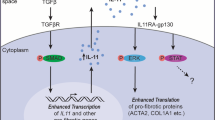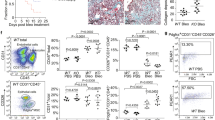Abstract
Aberrant wound-healing responses to injury have been implicated in the development of pulmonary fibrosis, but the mediators directing these pathologic responses have yet to be fully identified. We show that lysophosphatidic acid levels increase in bronchoalveolar lavage fluid following lung injury in the bleomycin model of pulmonary fibrosis, and that mice lacking one of its receptors, LPA1, are markedly protected from fibrosis and mortality in this model. The absence of LPA1 led to reduced fibroblast recruitment and vascular leak, two responses that may be excessive when injury leads to fibrosis rather than to repair, whereas leukocyte recruitment was preserved during the first week after injury. In persons with idiopathic pulmonary fibrosis, lysophosphatidic acid levels in bronchoalveolar lavage fluid were also increased, and inhibition of LPA1 markedly reduced fibroblast responses to the chemotactic activity of this fluid. LPA1 therefore represents a new therapeutic _target for diseases in which aberrant responses to injury contribute to fibrosis, such as idiopathic pulmonary fibrosis.
This is a preview of subscription content, access via your institution
Access options
Subscribe to this journal
Receive 12 print issues and online access
We are sorry, but there is no personal subscription option available for your country.
Buy this article
- Purchase on SpringerLink
- Instant access to full article PDF
Prices may be subject to local taxes which are calculated during checkout






Similar content being viewed by others
References
Selman, M., King, T.E. & Pardo, A. Idiopathic pulmonary fibrosis: prevailing and evolving hypotheses about its pathogenesis and implications for therapy. Ann. Intern. Med. 134, 136–151 (2001).
Martin, P. Wound healing–aiming for perfect skin regeneration. Science 276, 75–81 (1997).
Kuhn, C. et al. An immunohistochemical study of architectural remodeling and connective tissue synthesis in pulmonary fibrosis. Am. Rev. Respir. Dis. 140, 1693–1703 (1989).
Behr, J. et al. Fibroblast chemotactic response elicited by native bronchoalveolar lavage fluid from patients with fibrosing alveolitis. Thorax 48, 736–742 (1993).
Selman, M. et al. Accelerated variant of idiopathic pulmonary fibrosis: clinical behavior and gene expression pattern. PLoS ONE 2, e482 (2007).
Tager, A.M. et al. Inhibition of pulmonary fibrosis by the chemokine IP-10/CXCL10. Am. J. Respir. Cell Mol. Biol. 31, 395–404 (2004).
Phillips, R.J. et al. Circulating fibrocytes traffic to the lungs in response to CXCL12 and mediate fibrosis. J. Clin. Invest. 114, 438–446 (2004).
Moore, B.B. et al. The Role of CCL12 in the Recruitment of Fibrocytes and Lung Fibrosis. Am. J. Respir. Cell Mol. Biol. 35, 175–181 (2006).
van Nieuw Amerongen, G.P., Vermeer, M.A. & van Hinsbergh, V.W. Role of RhoA and Rho kinase in lysophosphatidic acid-induced endothelial barrier dysfunction. Arterioscler. Thromb. Vasc. Biol. 20, E127–E133 (2000).
Neidlinger, N.A., Larkin, S.K., Bhagat, A., Victorino, G.P. & Kuypers, F.A. Hydrolysis of phosphatidylserine-exposing red blood cells by secretory phospholipase A2 generates lysophosphatidic acid and results in vascular dysfunction. J. Biol. Chem. 281, 775–781 (2006).
Dvorak, H.F. Tumors: wounds that do not heal. Similarities between tumor stroma generation and wound healing. N. Engl. J. Med. 315, 1650–1659 (1986).
Idell, S. Coagulation, fibrinolysis, and fibrin deposition in acute lung injury. Crit. Care Med. 31, S213–S220 (2003).
Luster, A.D. Chemokines–chemotactic cytokines that mediate inflammation. N. Engl. J. Med. 338, 436–445 (1998).
Curry, S., Brick, P. & Franks, N.P. Fatty acid binding to human serum albumin: new insights from crystallographic studies. Biochim. Biophys. Acta 1441, 131–140 (1999).
Ridley, A.J. & Hall, A. The small GTP-binding protein rho regulates the assembly of focal adhesions and actin stress fibers in response to growth factors. Cell 70, 389–399 (1992).
Sugimoto, N., Takuwa, N., Yoshioka, K. & Takuwa, Y. Rho-dependent, Rho kinase-independent inhibitory regulation of Rac and cell migration by LPA1 receptor in Gi-inactivated CHO cells. Exp. Cell Res. 312, 1899–1908 (2006).
Ishii, I., Fukushima, N., Ye, X. & Chun, J. Lysophospholipid receptors: signaling and biology. Annu. Rev. Biochem. 73, 321–354 (2004).
Noguchi, K., Ishii, S. & Shimizu, T. Identification of p2y9/GPR23 as a novel G protein-coupled receptor for lysophosphatidic acid, structurally distant from the Edg family. J. Biol. Chem. 278, 25600–25606 (2003).
Lee, C.W., Rivera, R., Gardell, S., Dubin, A.E. & Chun, J. GPR92 as a new G(12/13)- and G(q)-coupled lysophosphatidic acid receptor that increases cAMP, LPA5. J. Biol. Chem. 281, 23589–23597 (2006).
Hama, K. et al. Lysophosphatidic acid and autotaxin stimulate cell motility of neoplastic and non-neoplastic cells through LPA1. J. Biol. Chem. 279, 17634–17639 (2004).
Contos, J.J., Fukushima, N., Weiner, J.A., Kaushal, D. & Chun, J. Requirement for the lpA1 lysophosphatidic acid receptor gene in normal suckling behavior. Proc. Natl. Acad. Sci. USA 97, 13384–13389 (2000).
Ohta, H. et al. Ki16425, a subtype-selective antagonist for EDG-family lysophosphatidic acid receptors. Mol. Pharmacol. 64, 994–1005 (2003).
Heise, C.E. et al. Activity of 2-substituted lysophosphatidic acid (LPA) analogs at LPA receptors: discovery of a LPA1/LPA3 receptor antagonist. Mol. Pharmacol. 60, 1173–1180 (2001).
Strutz, F. et al. Identification and characterization of a fibroblast marker: FSP1. J. Cell Biol. 130, 393–405 (1995).
Lawson, W.E. et al. Characterization of Fibroblast Specific Protein 1 in Pulmonary Fibrosis. Am. J. Respir. Crit. Care Med. 171, 899–907 (2005).
Bucala, R., Spiegel, L.A., Chesney, J., Hogan, M. & Cerami, A. Circulating fibrocytes define a new leukocyte subpopulation that mediates tissue repair. Mol. Med. 1, 71–81 (1994).
Moore, B.B. et al. CCR2-mediated recruitment of fibrocytes to the alveolar space after fibrotic injury. Am. J. Pathol. 166, 675–684 (2005).
Zhang, K., Rekhter, M.D., Gordon, D. & Phan, S.H. Myofibroblasts and their role in lung collagen gene expression during pulmonary fibrosis. A combined immunohistochemical and in situ hybridization study. Am. J. Pathol. 145, 114–125 (1994).
Zhou, D. et al. Phosphatidic acid and lysophosphatidic acid induce haptotactic migration of human monocytes. J. Biol. Chem. 270, 25549–25556 (1995).
Goetzl, E.J., Kong, Y. & Voice, J.K. Cutting edge: differential constitutive expression of functional receptors for lysophosphatidic acid by human blood lymphocytes. J. Immunol. 164, 4996–4999 (2000).
Picker, L.J. et al. Differential expression of homing-associated adhesion molecules by T cell subsets in man. J. Immunol. 145, 3247–3255 (1990).
Hara, T., Jung, L.K., Bjorndahl, J.M. & Fu, S.M. Human T cell activation. III. Rapid induction of a phosphorylated 28 kD/32 kD disulfide-linked early activation antigen (EA 1) by 12-o-tetradecanoyl phorbol-13-acetate, mitogens, and antigens. J. Exp. Med. 164, 1988–2005 (1986).
Maino, V.C., Suni, M.A. & Ruitenberg, J.J. Rapid flow cytometric method for measuring lymphocyte subset activation. Cytometry 20, 127–133 (1995).
Fireman, E. et al. Morphological and biochemical properties of alveolar fibroblasts in interstitial lung diseases. Lung 179, 105–117 (2001).
Basset, F. et al. Intraluminal fibrosis in interstitial lung disorders. Am. J. Pathol. 122, 443–461 (1986).
Mills, G.B. & Moolenaar, W.H. The emerging role of lysophosphatidic acid in cancer. Nat. Rev. Cancer 3, 582–591 (2003).
Peng, X. et al. Protective effects of sphingosine 1-phosphate in murine endotoxin-induced inflammatory lung injury. Am. J. Respir. Crit. Care Med. 169, 1245–1251 (2004).
Chambers, R.C. & Laurent, G.J. Coagulation cascade proteases and tissue fibrosis. Biochem. Soc. Trans. 30, 194–200 (2002).
Kim, K.K. et al. Alveolar epithelial cell mesenchymal transition develops in vivo during pulmonary fibrosis and is regulated by the extracellular matrix. Proc. Natl. Acad. Sci. USA 103, 13180–13185 (2006).
Munger, J.S. et al. The integrin alpha v beta 6 binds and activates latent TGF beta 1: a mechanism for regulating pulmonary inflammation and fibrosis. Cell 96, 319–328 (1999).
Boucharaba, A. et al. Platelet-derived lysophosphatidic acid supports the progression of osteolytic bone metastases in breast cancer. J. Clin. Invest. 114, 1714–1725 (2004).
Honda, Y., Tsunematsu, K., Suzuki, A. & Akino, T. Changes in phospholipids in bronchoalveolar lavage fluid of patients with interstitial lung diseases. Lung 166, 293–301 (1988).
Goetzl, E.J. et al. Gelsolin binding and cellular presentation of lysophosphatidic acid. J. Biol. Chem. 275, 14573–14578 (2000).
Dinubile, M.J. Plasma gelsolin: in search of its raison d'etre. Focus on “Modifications of cellular responses to lysophosphatidic acid and platelet-activating factor by plasma gelsolin”. Am. J. Physiol. Cell Physiol. 292, C1240–C1242 (2007).
Allport, J.R. et al. Neutrophils from MMP-9- or neutrophil elastase-deficient mice show no defect in transendothelial migration under flow in vitro. J. Leukoc. Biol. 71, 821–828 (2002).
Kim, N.D., Chou, R.C., Seung, E., Tager, A.M. & Luster, A.D. A unique requirement for the leukotriene B4 receptor BLT1 for neutrophil recruitment in inflammatory arthritis. J. Exp. Med. 203, 829–835 (2006).
Xiao, Y.J. et al. Electrospray ionization mass spectrometry analysis of lysophospholipids in human ascitic fluids: comparison of the lysophospholipid contents in malignant vs nonmalignant ascitic fluids. Anal. Biochem. 290, 302–313 (2001).
Means, T.K., Hayashi, F., Smith, K.D., Aderem, A. & Luster, A.D. The Toll-like receptor 5 stimulus bacterial flagellin induces maturation and chemokine production in human dendritic cells. J. Immunol. 170, 5165–5175 (2003).
Reutershan, J. et al. Critical role of endothelial CXCR2 in LPS-induced neutrophil migration into the lung. J. Clin. Invest. 116, 695–702 (2006).
Medoff, B.D. et al. BLT1-mediated T cell trafficking is critical for rejection and obliterative bronchiolitis after lung transplantation. J. Exp. Med. 202, 97–110 (2005).
Acknowledgements
The authors gratefully acknowledge that these studies were supported by a Pulmonary Fibrosis Foundation Grant, an American Lung Association Dalsemer Grant, and a Nirenberg Center for Advanced Lung Disease Grant (to A.M.T.), by Universidad Nacional Autónoma de México Grant SDI.PTID.05.6 (to M.S. and A.P.) and by US National Institutes of Health grants R01-CA89228 and R01-CA095042 (to Y.X.), R01-MH51699, K02-MH01723 and R01-NS048478 (to J.C.) and R01-CA69212 (to A.D.L.). The authors thank C.P. Leary for her assistance, S.D. Bercury, E.C. Poorvu and S.F. Brooks for their technical assistance, and K.R. Lynch for the gift of VPC12249.
Author information
Authors and Affiliations
Contributions
A.M.T. conceived the idea for the study, designed, directed and interpreted all of the experiments, and prepared the manuscript. P.L. performed and analyzed the experiments comparing fibrosis and mortality in LPA1-deficient and wild-type mice. P.L. and B.S.S. performed and analyzed the experiments comparing fibroblast accumulation and vascular leak in LPA1-deficient and wild-type mice. P.L., B.S.S., B.A.K.-S. and W.K.H. performed and analyzed the experiments comparing leukocyte recruitment in LPA1-deficient and wild-type mice. G.S.C. performed and analyzed the chromatography and SDS-PAGE experiments. M.S., J.W., A.P., B.S.S. and A.M.T. collected and provided the human BAL samples. Z.Z. and Y.X. performed and analyzed the mass spectrometry experiments. V.P. and T.S.B. performed and analyzed the FSP1 staining. N.D.K. isolated and provided the primary mouse lung endothelial cells and mouse neutrophils. W.K.H. performed the chemotaxis and QPCR experiments. J.C. provided the LPA1-deficient mice. P.L., B.S.S., M.S. A.P., T.S.B., Y.X., and J.C. provided critical review and comments on the manuscript. A.D.L. supervised all aspects of the study, including experimental design, data interpretation, and manuscript preparation.
Corresponding author
Supplementary information
Supplementary Text and Figures
Supplementary Figs. 1–4 (PDF 2341 kb)
Rights and permissions
About this article
Cite this article
Tager, A., LaCamera, P., Shea, B. et al. The lysophosphatidic acid receptor LPA1 links pulmonary fibrosis to lung injury by mediating fibroblast recruitment and vascular leak. Nat Med 14, 45–54 (2008). https://doi.org/10.1038/nm1685
Received:
Accepted:
Published:
Issue Date:
DOI: https://doi.org/10.1038/nm1685



